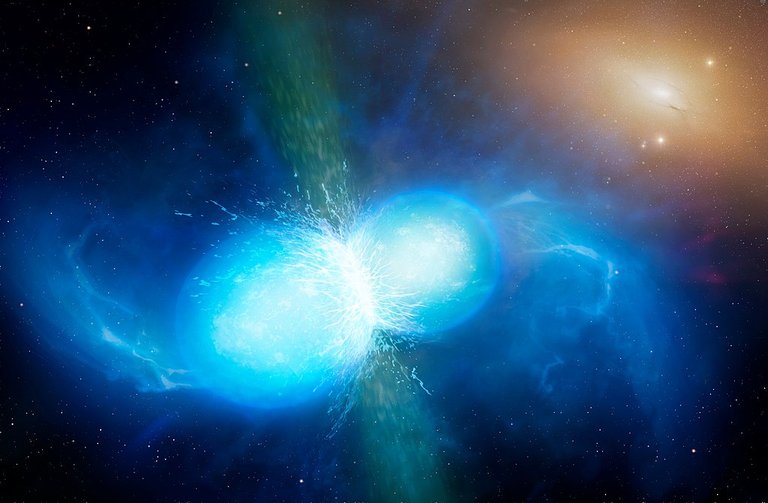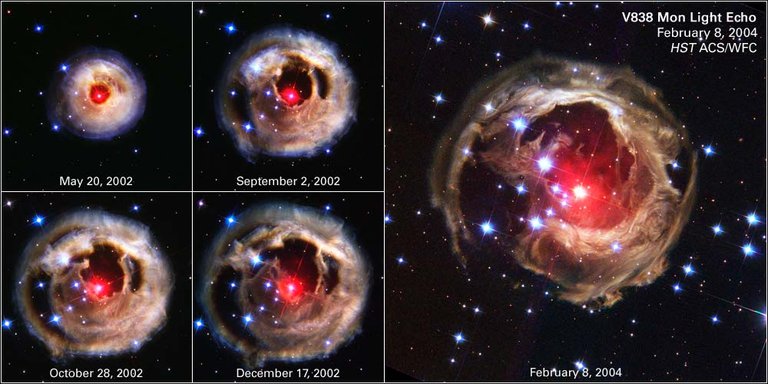According to Professor Larry Molnar of Calvin College in Michigan, there will be a big event in the constellation Cygnus in the next few years. It should come to a fusion of two orbiting stars. Already in the year 2022 (+/- 7 months) the process should begin and produce a "new" star.
The artistic representation of two merging neutron stars.

Copyright: University of Warwick/Mark Garlick, Attribution 4.0 International (CC BY 4.0)
Two dim stars in the constellation Cygnus orbit each other always faster and closer. They should already be touching each other and will most likely merge in the next few years. As a result, the brightness of the former binary star system will increase by a factor of 10000 during this process, resulting in a red star (Red Nova) visible to the naked eye. This is predicted by the American astronomer, Professor Larry Molnar from Calvin College in Michigan. His thesis is based on a well-studied precedent from the year 2008.
Precedent Nova Scorpii 2008
The Nova Scorpii 2008, which was later cataloged as V1309 Scorpii, first appeared to be an ordinary nova explosion. Such nova explosions are caused by the accumulation of matter from a companion, which causes a thermonuclear explosion that will happen on the surface of the star that receives the matter when a critical mass is exceeded. However, the process was different from that of a usual nova explosion.
The two stars orbited every 1.4 days and this period became shorter and shorter. Practically was, that the stars darkened each other at its orbits, so that the period could easily be read from the light curve.
The two stars had become so close to each other in 2008 that they merged and formed a "new" star. Through this process, enormous amounts of energy were released (Mergerburst), which led to a brightness increase similar to a nova explosion. This is also referred to as "Red Nova" and also fits a few past events observed in our and other galaxies.
In the end, a "newly" born single star remains, which will slowly cool down.
V838 Monocerotis, maybe a possible luminous red nova.

Copyright: NASA, ESA, H.E. Bond (STScI) and The Hubble Heritage Team (STScI/AURA), public domain
Same scenario for double star KIC 9832227
Exactly this scenario should repeat itself at the beginning of the year 2022 (+/- 7 months) with the double star system KIC 9832227 in the constellation Cygnus and be visible for us with the naked eye. As with Nova Scorpii 2008, it will also end with KIC 9832227. Currently, the two stars orbit each other with a period of about 11 hours, which is getting shorter and shorter.
Three years ago Professor Larry Molnar pointed out this possible scenario for the first time. On 06th January 2017, he officially announced that the rapid orbit decay follows exactly the model of Nova Scorpii 2008.
The two stars have about 1.4 and 0.3 solar masses. Unfortunately, it is still uncertain what exactly will happen when they merge into a "new" star in a few years. However, it is roughly estimated that the brightness will increase over about 6 months and that it will hold the maximum brightness value of +2 mag (about the brightness of Polaris) for some months.
The double star system KIC 9832227 is still inconspicuous.

Copyright: Evan Cook, GNU Free Documentation License, version 1.2
Conclusion
A large observation campaign is already in preparation. Amateur astronomers, in particular, should play a major role in observing and collecting data, since their "small" telescopes are better suited for some things than the extremely light-sensitive telescopes of astronomers.
The current brightness of the double star system KIC 9832227 is about +12 mag (darker than Neptune but brighter than Pluto) and can also be captured in smaller telescopes or standard lenses with corresponding focal lengths by long-term exposures.
I will try to get some beautiful images of this region while the Red Nova is not yet visible. I still have a little time for that. From the beginning of 2022, I will visit this region a bit more often, hoping to catch the beginning and do a kind of time-lapse of the process. Hopefully, the weather will play along.
So if someone wants to make astrophotographs that show something special, he has the opportunity to do so. Who knows when something like this will happen again. Since the brightness should reach that of Polaris, the fusion will also be well seen in widefield images of the Milkyway.
So remember the approximate time period and let your Astro-enthusiastic friends know. The more data there is about this process and the better it is documented, the more detailed it can be researched. Who knows, many astonishing discoveries will be made through your picture!
References:
https://www.aanda.org/articles/aa/full_html/2011/04/aa16221-10/aa16221-10.html
https://abenteuer-astronomie.de/um-2022-heller-roter-stern-soll-im-schwan-aufleuchten/
https://calvin.edu/news/archive/astronomy-prof-student-predict-explosion-that-will-change-the-night-sky
https://de.wikipedia.org/wiki/KIC_9832227
https://de.wikipedia.org/wiki/Mergerburst
https://en.wikipedia.org/wiki/Luminous_red_nova
Thank you very much for visiting and reading!
I hope this has been a useful post for you. If you have any questions or suggestions, please don't be afraid to let me know of anything you thought about this post in the comments below!
Yours, @astrophoto.kevin
Copyright note for my pictures:
All images, otherwise clearly indicated, in this post are my own work.
You can use it for free if you credit them to @astrophoto.kevin.

SteemSTEM is a community project with the goal to promote and support Science, Technology, Engineering and Mathematics on the Steem blockchain. If you wish to support the steemSTEM project you can:
Contribute STEM content using the #steemstem tag | Support steemstem authors | Join our curation trail | Visit our Discord community | Delegate SP to steemstem
I hope you are able to show us more about this event!
I hope it also :-)
Fortunately, I still have some time to practice.
What a fantastic event. The very idea of:-
Is simply astonishing.
This is great news to spread around.
Thank you very much @molometer
That's true. Also the also "event" is astonishing. When you consider that two suns merge into one and which forces and energies are involved due to this.
It is mind blowing to consider the forces involved. Very exciting stuff. I got your confirmation on Discord. Thanks. See you over there sometime soon. :-)
I just bought a canon 70-300 mm lens today. It may help me to get some decent images while I consider which telescope to invest in.
Great :-)
I started first with a Sigma 100-300 f4. This was a great lens but unfortunately very heavy.
Don't choose the telescope too big, this makes it a lot easier when you start. :-)
And the most important thing in astrophotography is the mount. Which you also can use with your camera and lens ;-)
I'm thinking about getting a motorized mount when I get the telescope so I can use it for tracking stars and also for time lapse in the daytime.
Early results from the 70-300 mm are very encouraging.
I used it yesterday to photograph some wild fowl which was tricky. I should have brought the tripod as the lens exaggerated the slightest movement as you probably know. :-)
Lucky I shot them in RAW. It saved the days shoot.
But the mounts are very heavy and unwieldy. Mine is a "medium sized" and weights around 27 kg without 10kg counterweights. Or are you looking for a small portable star tracker? That would be critical with an telescope.
I saw your post this morning, great shots :-)
Do the lense has an image stabilisation? This could help. Yes that's true, 300mm can be very shivery. RAW files leave so much room for editing, that's amazing.
I was thinking of a small portable star tracker which would be more portable. I'll have to do some in depth research to find the optimal arrangement.
I have dark skies where I live so that's good. No light pollution.
The lens has a three-stop Image stabilizer The images would have been very bad without it as you know how difficult hand held is.
Still a tripod would have been helpful. Next time I'll use one :-)
The quality of your post is amazing Kevin!
Thank you very much David :-)
And thank you very much for your kind support :-)
As a follower of @followforupvotes this post has been randomly selected and upvoted! Enjoy your upvote and have a great day!
Hi @astrophoto.kevin!
Your post was upvoted by @steem-ua, new Steem dApp, using UserAuthority for algorithmic post curation!
Your UA account score is currently 2.460 which ranks you at #16439 across all Steem accounts.
Your rank has dropped 49 places in the last three days (old rank 16390).
In our last Algorithmic Curation Round, consisting of 282 contributions, your post is ranked at #185.
Evaluation of your UA score:
Feel free to join our @steem-ua Discord server
This post has been voted on by the steemstem curation team and voting trail.
There is more to SteemSTEM than just writing posts, check here for some more tips on being a community member. You can also join our discord here to get to know the rest of the community!
Hi @astrophoto.kevin!
Your post was upvoted by utopian.io in cooperation with steemstem - supporting knowledge, innovation and technological advancement on the Steem Blockchain.
Contribute to Open Source with utopian.io
Learn how to contribute on our website and join the new open source economy.
Want to chat? Join the Utopian Community on Discord https://discord.gg/h52nFrV